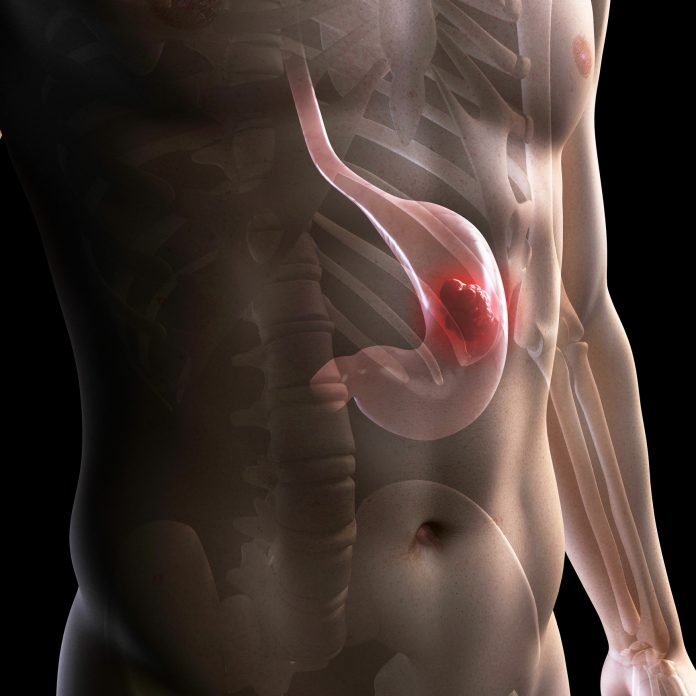
A new study in Cancer Cell reveals evolutionary clues in the tumor microenvironment during gastric cancer progression. Researchers from the University of Texas MD Anderson Cancer Center learned that the presence of certain types of cell groupings were linked with clinical outcomes. The study provides a high-resolution gastric cancer tumor microenvironment atlas with cell groupings in the gastric cancer tumor microenvironment that suggest potential targets for further investigation.
Gastric cancer has long been considered a disease characterized by genomic/epigenetic alterations and chromosomal instability. However, the role of immune and stromal cells within the tumor microenvironment is now increasingly recognized. The team’s goal was to see how tumor microenvironment reprogramming during the evolution of gastric cancer might lead to the discovery of new drug targets.
“Gastric adenocarcinoma exhibits a high degree of heterogeneity with respect to both its phenotypes and molecular characteristics, but research around it has lagged behind other cancer types,” said co-principal author Linghua Wang, MD, PhD, associate professor of Genomic Medicine at MD Anderson Cancer Center. “Most studies have concentrated on tumor cells and largely overlooked the immune and stromal cells within the tumor microenvironment, which are very dynamic and play critical roles in cancer progression. This study represents the largest single-cell RNA sequencing cohort of gastric adenocarcinoma to date and brings important new insights into how these cell populations impact disease progression.”
By obtaining single-cell RNA sequencing (scRNA-seq) data from 68 gastric adenocarcinoma samples from 43 subjects encompassing various disease stages—including precancerous lesions, localized tumors, and distant metastases in the peritoneal cavity, ovary, and liver—along with normal tissue and peripheral blood samples, the team characterized the changing immune and stromal cell populations within the tumor microenvironment and discovered exploitable targets to modulate the tumor microenvironment. Stromal cells are a highly heterogeneous group of connective tissue cells.
Specifically, among the more than 77,000 single cells profiled, the researchers observed abundant IgA+ plasma cells exist in the premalignant microenvironment whereas immunosuppressive myeloid and stromal subsets dominate in later-stage gastric cancers.
Their analysis reveals six unique tumor microenvironments dominated by various immune and stromal cell groups, or ecotypes, among the samples. EC1 is exclusive to blood, while EC4, EC5, and EC2 are highly enriched in uninvolved tissues, premalignant lesions, and metastatic tumors, respectively. The two others, EC3 and EC6, were found in primary gastric cancers and included a range of histopathological and genomic characteristics, and survival outcomes.
Tumors categorized as EC3 were composed mainly of immune cell subsets, whereas EC6 tumors predominantly included stromal cell subsets. Patients with EC6 tumors had more aggressive disease and significantly shorter survival compared to those with EC3 tumors. The prevalence of stromal cells negatively correlated with immune cells such as CD4+/CD8+ T and NK cells. Stroma-rich EC6 gastric cancers exhibited a paucity of these immune cells.
The researchers dug deeper into understanding the specifics of the EC6 ecotype, focusing on its stromal cell constituents. Though known to have important roles in tumor development and progression, consideration of stromal cell components within a tumor microenvironment are not part of treatment decisions in gastric cancer. However, this study reveals extensive stromal remodeling occurs in gastric cancer progression.
In particular, the researchers identified SDC2 as a potential target worthy of further investigation. Researchers found SDC2 overexpression in stromal cells, especially in cancer-associated fibroblasts, was correlated with aggressive disease and advanced stages, poor survival, and contributed to tumor growth. In addition, SDC2 expression was consistently elevated in stromal cells across various other cancer types, including pancreatic cancer, colorectal cancer, bladder cancer, breast cancer, and clear cell renal cell carcinoma. The findings suggest that targeting SDC2 in cancer-associated fibroblasts represents a notable target warranting further study.
“While many published single-cell studies have focused on characterizing the heterogeneity of each individual cell compartment, our study utilized a novel approach and concept of integrating various components of the tumor microenvironment to define ecotypes and investigated their clinical significance,” said Wang. “This approach can readily be applied to studies in other cancer types.”
Results of the study are freely available through the online Single-Cell Research Portal developed by the Wang Lab.











